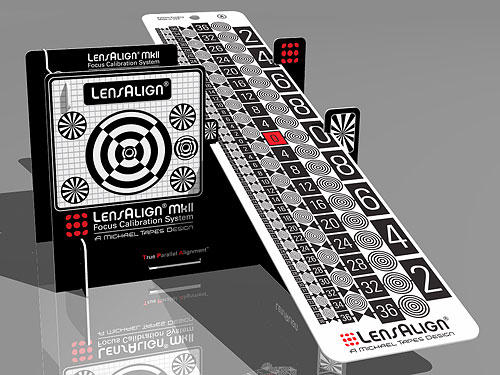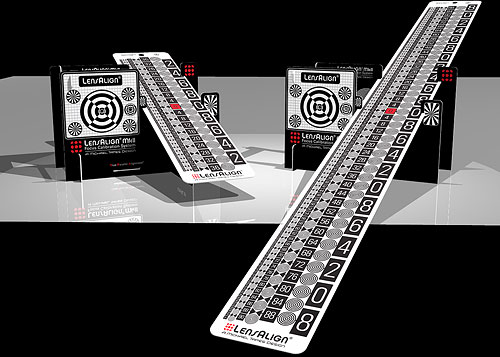Numerous prosumer and professional DSLRs these days provide an autofocus microadjustment feature, including models from Canon, Nikon, Sony, Olympus, and Pentax. If your camera includes such a feature, you've a fairly powerful tool at your disposal, allowing you to correct for focus issues with your specific lenses and camera bodies. Without a clear way to determine where your point of focus lies, though, it can be a frustrating experience trying to correct focus, and if your alignment isn't good you can easily exacerbate things -- or at the very least, muddy the waters as to where your problems lie.
Two years ago, Michael Tapes stepped in to introduce a solution, in the form of the LensAlign series. When we reviewed the LensAlign Pro at the time, we found it to be a well-designed and useful tool for photographers needing to fine-tune their cameras' autofocus systems. The new LensAlign MkII joins the Pro model in the lineup, at roughly the same $80 pricepoint as the discontinued Lite model. While it forgoes some of the more pro-oriented features of its more expensive sibling, the LensAlign MkII does include Tapes' patent-pending True Parallel Alignment sighting system, and just like the Pro model, can be used on a table-top or tripod mounted.
The TPA sighting system makes it relatively easy to ensure that the focus target and sensor planes are parallel, with correct alignment being an important part of ensuring consistent and accurate results. The system consists of two sets of small holes in the focus target, and the rear plate of the LensAlign. You simply look at either focus target hole through the viewfinder or using your camera's Live View mode, and adjust the position of the camera or focus target until a small red dot that surrounds the hole in the rear plate is perfectly centered within the focus target hole. You can then be sure that the focus target and sensor plane are parallel, something that can be tricky to confirm with some competing devices such as Datacolor's SpyderLensCal, let alone home-brewed focus targets. The remainder of the calibration process is pretty straightforward. The camera is set up appropriately, then autofocused on the LensAlign's focus target, and one or more photos captured. An adjacent angled ruler makes it easy to see where the actual focus point lies, and whether it correctly matches the focus target plane, or indicates front- or backfocusing. An adjustment can then be made using the camera body's adjustment feature, and the process repeated to confirm an improvement in autofocus performance.

|
The LensAlign MkII, shown assembled with the standard 10.5-inch ruler attached.
Rendering provided by Michael Tapes Design. |
Compared to the LensAlign Pro, there are a number of important differences in the LensAlign MkII. For enthusiast photographers, pricing will likely be among the main considerations, and with a price tag fully $100 less than the Pro variant, which ships for around US$180, the LensAlign MkII has a significant advantage. (By way of comparison, Datacolor's SpyderLensCal, which lacks any equivalent of LensAlign's TPA system, is priced at US$60.) The LensAlign MkII ships as seven component parts, which quickly and precisely slot together to provide the required accuracy for the TPA sighting system, thanks to precision manufacturing. This gives the MkII the advantage of being able to be disassembled for travel or longer-term storage, although it's not intended to be dismantled after every use. By comparison, the LensAlign Pro ships preassembled and laser-certified at the factory, and can't be disassembled for travel or storage.
The standard 10.5-inch ruler of the LensAlign MkII is also just slightly longer than the 9.5-inch ruler of the Pro model, although both devices can accept optional long ruler kits. Here, the Pro model has a clear advantage, with an available 48-inch ruler and larger focus target, versus the 24-inch long ruler kit for the MkII. The standard rulers also differ in design and materials, with the Pro model's 9.5-inch ruler being single-sided and made of stainless steel, where the MkII's 10.5-inch ruler is double-sided with different display surface designs on each side, and made from sheet polystyrene. The LensAlign Pro's ruler angle is adjustable to five preset angles between 5 and 45 degrees, though, unlike the fixed 20-degree ruler angle of the LensAlign MkII. The lower-cost model also lacks the Enumerator feature of the LensAlign Pro, which can be used to provide visual documentation of distance and microfocus adjustment settings in captured images.
The LensAlign MkII will begin shipping in about a week's time, priced at US$79.95. Preorders are now being accepted on the Michael Tapes Design website.The 24-inch ruler kit for the LensAlign MkII will ship from the start of February 2011, and pricing for this option has not yet been announced. For a limited time, a free WhiBal G7 keychain card, ordinarily priced at $18.95, will ship with LensAlign MkII orders. Shipping is in the region of $6 for US orders, or $13 for international orders, using priority mail.
Sharp-eyed readers will note the reference to a G7 variant of the WhiBal card in the previous paragraph. That's not a typo -- a new version of the popular, certified neutral, white balance reference cards are also now shipping. Compared to the G6 version, WhiBal G7 cards are thinner, and use a sandwiched design with a neutral gray substrate surrounded by polycarbonate on each side, providing protection from scratches. As with G6 models, the WhiBal G7 cards are available in keychain, pocket, studio, and reference sizes, although the precise dimensions for all but the studio size differ just slightly from the WhiBal G6 equivalents. The WhiBal G7 Pocket and Studio kits replace their G6 equivalents' table stand with a stainless steel S-Biner hook that can act both as a table stand and hanging device, and swap the previous carrying case for an ultra-thin Tyvek storage sleeve. The G7 Studio kit also bundles the same quick-release lanyard that's included with G6 and G7 Pocket kits. As with the G6 series, the WhiBal G7 products are guaranteed neutral, waterproof, scratch resistant, fade-proof, low-glare, and include an inch / centimeter scale. All but the keychain size also provide both black and white reference patches. Prices vary from $18.95 to $59.95 depending on the size and bundle chosen. More details can be found on the WhiBal product page.

|
LensAlign MkII with standard 10.5-inch ruler (left) and optional 24-inch long ruler (right).
Rendering provided by Michael Tapes Design. |